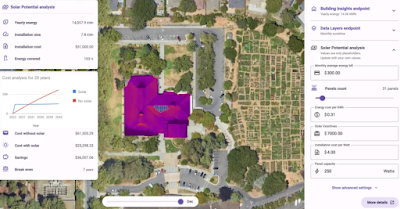--AD--
Back in 2015, Google introduced Project Sunroof, a remarkable Maps feature that merged location, sunlight, and navigation information to display potential energy generation from solar panels installed on various residential roofs. Whether it was your own house or your neighbor's, Google meticulously mapped this data for nearly every household worldwide. This initiative not only propelled the company's environmental sustainability endeavors but also highlighted the exceptional technical prowess of the platform.
During the Google Cloud Next event on Tuesday, the company is set to introduce a comprehensive collection of fresh sustainability APIs. These APIs tap into Google's AI initiatives, equipping developers with up-to-the-minute insights on solar capacity, air quality, and pollen levels. Through these resources, Google aims to make strides towards their objective of aiding individuals, communities, and collaborators in collectively diminishing 1 gigaton of carbon-equivalent emissions each year by 2030. Yael Maguire, VP of Geo Sustainability at Google, highlights these advancements in an upcoming blog post on Maps.
Derived from the foundational efforts of Project Sunroof, the Solar API advances with the integration of contemporary mapping technology and enhanced computational capabilities. This evolution surpasses its predecessor by leveraging state-of-the-art resources. Spanning across 40 countries, including the US, France, and Japan, the API will encompass a staggering 320 million buildings. Yael Maguire shared this insight with reporters during a confidential briefing held on Monday.
"There has been a substantial surge in the demand for solar energy in recent years," remarked Maguire. He highlighted that search queries related to "rooftop solar panels and power" escalated by 60 percent in the year 2022. "As we witness this significant shift towards solar adoption," Maguire emphasized, "we identified a wealth of potential to extend this knowledge and technological innovation to global businesses."
The team undertook the training of an AI model to meticulously derive accurate rooftop angles and inclinations from overhead satellite or aerial imagery. Complementing this, the model also provides estimates of shading caused by neighboring trees. This wealth of information is then amalgamated with historical weather data and prevailing energy costs. Consequently, installation companies and homeowners can access a comprehensive assessment of potential solar panel output without necessitating the physical dispatch of a technician to the site.
Google is further expanding its Air Quality layer, initially proven invaluable during the 2021 California Wildfires and subsequent incidents, by transforming it into a distinct API available across more than 100 countries worldwide.
Yael Maguire elucidates, "This API undertakes the validation and organization of several terabytes of data per hour from diverse sources, including governmental monitoring stations, meteorological data, sensors, and satellites. The result is a localized and comprehensive air quality index."
Notably, the system incorporates real-time traffic conditions and vehicular volume to enhance predictions about prevalent pollutants. Maguire affirms, "This methodology equips businesses across sectors like healthcare, automotive, and transportation with the capability to deliver precise and timely air quality insights to their users, regardless of their location."
Beyond addressing human-induced pollutants, Google is also advancing its existing pollen tracking feature within Maps, elevating it to a comprehensive API. "The surge in temperatures and emissions of greenhouse gases has led to the expansion of pollen-producing vegetation into new areas, leading to heightened pollen production. This, in turn, exacerbates challenges for individuals dealing with seasonal allergies," Maguire explained.
The forthcoming Pollen API will meticulously monitor the seasonal dispersion of tree pollen across over 65 countries. It will integrate localized wind patterns and annual trends, supplying users with pertinent data on local pollen counts, comprehensive allergen insights, and visual heatmaps indicating areas with heightened pollen activity. Maguire envisions this data benefiting travel planning applications, stating, "It will enhance the planning process for daily commutes or vacations." Developers will be able to access these apps starting August 29th.




Comments
Post a Comment
Important - If you ask a question make sure you tick the "Notify Me" box below the comment form to be notified of follow up comments and replies.